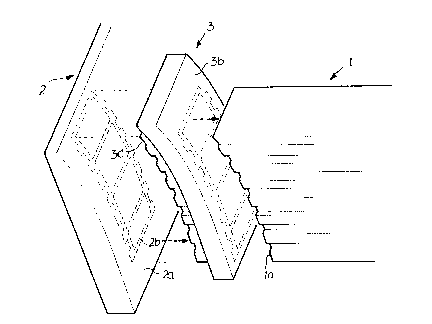Une partie des informations de ce site Web a été fournie par des sources externes. Le gouvernement du Canada n'assume aucune responsabilité concernant la précision, l'actualité ou la fiabilité des informations fournies par les sources externes. Les utilisateurs qui désirent employer cette information devraient consulter directement la source des informations. Le contenu fourni par les sources externes n'est pas assujetti aux exigences sur les langues officielles, la protection des renseignements personnels et l'accessibilité.
L'apparition de différences dans le texte et l'image des Revendications et de l'Abrégé dépend du moment auquel le document est publié. Les textes des Revendications et de l'Abrégé sont affichés :
| (12) Brevet: | (11) CA 2016054 |
|---|---|
| (54) Titre français: | PROCEDE DE SOUDAGE DE PROFILES, PARTICULIEREMENT DE PROFILES EN PLASTIQUE |
| (54) Titre anglais: | PROCESS FOR WELDING PROFILES, IN PARTICULAR PLASTIC PROFILES |
| Statut: | Périmé et au-delà du délai pour l’annulation |
| (51) Classification internationale des brevets (CIB): |
|
|---|---|
| (72) Inventeurs : |
|
| (73) Titulaires : |
|
| (71) Demandeurs : |
|
| (74) Agent: | SMART & BIGGAR LP |
| (74) Co-agent: | |
| (45) Délivré: | 1999-08-03 |
| (22) Date de dépôt: | 1990-05-04 |
| (41) Mise à la disponibilité du public: | 1990-11-05 |
| Requête d'examen: | 1997-02-25 |
| Licence disponible: | S.O. |
| Cédé au domaine public: | S.O. |
| (25) Langue des documents déposés: | Anglais |
| Traité de coopération en matière de brevets (PCT): | Non |
|---|
| (30) Données de priorité de la demande: | ||||||
|---|---|---|---|---|---|---|
|
There is described a process for welding profiles, in
particular plastic profiles as used for windows, doors, or the
like. The two profile areas that are to be welded together are
heated to welding temperature and then joined together after
this heating process. When this is done, the face surface of
the first profile and the surface of the second profile,
transverse thereto, is heated. The heating of the second profile
is confined to a surface area which, according to position and
configuration, matches the face surface of the first profile.
The profiling of the surface of the second profile matches at
least in part the face surface profiling of the first profile.
Using this process, it is possible to weld variously shaped
profiles, in particular plastic profiles, tightly to each other.
Note : Les revendications sont présentées dans la langue officielle dans laquelle elles ont été soumises.
Note : Les descriptions sont présentées dans la langue officielle dans laquelle elles ont été soumises.

2024-08-01 : Dans le cadre de la transition vers les Brevets de nouvelle génération (BNG), la base de données sur les brevets canadiens (BDBC) contient désormais un Historique d'événement plus détaillé, qui reproduit le Journal des événements de notre nouvelle solution interne.
Veuillez noter que les événements débutant par « Inactive : » se réfèrent à des événements qui ne sont plus utilisés dans notre nouvelle solution interne.
Pour une meilleure compréhension de l'état de la demande ou brevet qui figure sur cette page, la rubrique Mise en garde , et les descriptions de Brevet , Historique d'événement , Taxes périodiques et Historique des paiements devraient être consultées.
| Description | Date |
|---|---|
| Le délai pour l'annulation est expiré | 2001-05-04 |
| Lettre envoyée | 2000-05-04 |
| Accordé par délivrance | 1999-08-03 |
| Inactive : Page couverture publiée | 1999-08-02 |
| Inactive : Taxe finale reçue | 1999-04-21 |
| Préoctroi | 1999-04-21 |
| Un avis d'acceptation est envoyé | 1998-12-18 |
| Un avis d'acceptation est envoyé | 1998-12-18 |
| Lettre envoyée | 1998-12-18 |
| Inactive : Renseign. sur l'état - Complets dès date d'ent. journ. | 1998-12-14 |
| Inactive : Dem. traitée sur TS dès date d'ent. journal | 1998-12-14 |
| Inactive : Approuvée aux fins d'acceptation (AFA) | 1998-11-04 |
| Réputée abandonnée - omission de répondre à un avis sur les taxes pour le maintien en état | 1997-05-05 |
| Inactive : Demande ad hoc documentée | 1997-05-05 |
| Exigences pour une requête d'examen - jugée conforme | 1997-02-25 |
| Toutes les exigences pour l'examen - jugée conforme | 1997-02-25 |
| Demande publiée (accessible au public) | 1990-11-05 |
| Date d'abandonnement | Raison | Date de rétablissement |
|---|---|---|
| 1997-05-05 |
Le dernier paiement a été reçu le 1999-04-07
Avis : Si le paiement en totalité n'a pas été reçu au plus tard à la date indiquée, une taxe supplémentaire peut être imposée, soit une des taxes suivantes :
Veuillez vous référer à la page web des taxes sur les brevets de l'OPIC pour voir tous les montants actuels des taxes.
| Type de taxes | Anniversaire | Échéance | Date payée |
|---|---|---|---|
| TM (demande, 8e anniv.) - générale | 08 | 1998-05-04 | 1998-02-17 |
| TM (demande, 9e anniv.) - générale | 09 | 1999-05-04 | 1999-04-07 |
| Taxe finale - générale | 1999-04-21 |
Les titulaires actuels et antérieures au dossier sont affichés en ordre alphabétique.
| Titulaires actuels au dossier |
|---|
| BRUGMANN FRISOPLAST GMBH |
| Titulaires antérieures au dossier |
|---|
| WOLF-JURGEN BRICKENSTEIN |